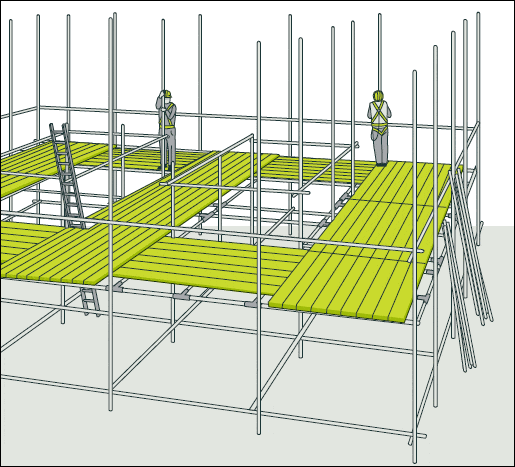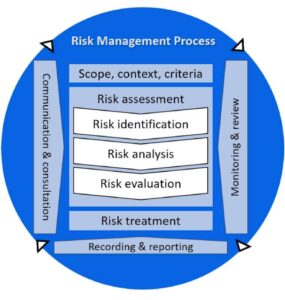How to calculate scaffolding load

how to calculate scaffolding laod
How to calculate scaffolding load scaffolding should be intended for the worst combination of dead loads (self-weight) & live loads (temporary burdens) that can be normal during the period that the scaffold is required to be in use. The foundations & any supporting structure of a scaffold structure must be able to distribute the load properly from top to the bottom
DEAD LOAD (SELF WEIGHT)
The dead load incorporates all segments and equipment which are a part of the scaffolding. This includes platforms, structural components, scaffold sheeting, edge protection, suspension cables, hoists, etc.
LIVE LOAD or (TEMPORARY LOAD)
They consisting of:
Live load is consisting of duty live loads (Classified as special, medium, light) including individuals working on the scaffold & stacked materials
Environmental loads including:
Environmental loads including wind loads on stacked materials, toe boards, sheeting or planks, platform ropes, guardrails, guy wires, screens, and other attachments.
Earthquake loads.
Snow loads
rain and ice stacks areas where they may influence the scaffolding.
impact loads (unexpected or sudden loadings, for example, materials being put on or removed)
Scaffolds must not be used utilized to hoist any plant equipment or formworks, for example, during concrete works unless the scaffolding is specifically designed for that work.

How to calculate scaffolding load different materials approximate weight.
| MATERIAL | APPROXIMATE WEIGHT |
| Bricks | 4 kg per brick |
| Cement | 40 kg per bag |
| Concrete block 400 x 200 x 200 mm hollow | 19 kg per block |
| Concrete block 400 x 200 x 150 mm hollow | 16 kg per block |
| Concrete block 400 x 200 x 100 mm hollow | 13 kg per block |
| Concrete block 400 x 200 x 100 mm solid | 16 kg per block |
| Concrete ready mixed wet | 2550 kg per cubic metre |
| Concrete in wheelbarrow | 140 kg |
| Drums empty | 200 litre 13 kg |
| Marble | 2700 kg per cubic metre |
| Paint five litres | 10 kg |
| Persons single | 100 kg |
| Persons plus wheelbarrow with concrete | 220 kg |
| Plaster fibrous | 1.6 kg per square metre |
| Plaster bag | 38 kg |
| Plywood 17 mm | 10 kg per square metre |
| Sand | 2000 kg per cubic metre |
| Shale | 2600 kg per cubic metre |
| Steel rods 6.5 mm diameter | 25 kg per 100 m |
| Steel rods 10 mm diameter | 67 kg per 100 m |
| Steel rods 12 mm diameter | 89 kg per 100 m |
| Steel rods 16 mm diameter | 158 kg per 100 m |
| Steel rods 20 mm diameter | 247 kg per 100 m |
| Steel rods 25 mm diameter | 358 kg per 100 m |
| Tiles terra cotta | 3.5 kg per tile |
| Tiles concrete | 3.75 kg per tile |
| Timber hardwoods | 1100 kg per cubic metre |
| Timber softwoods | 640 kg per cubic metre |
| Water (excluding container) | 1 kg per litre |
| Right angle coupler | 1 kg |
| Single coupler | 0.6 kg |
| Joiner | 0.8 kg |
| Swivel coupler | 1.2 kg |
| 3 m laminated timber plank | 18 kg |
| 48.3 mm galvanised scaffold tube 1 m | 4.4 kg per metre |
Duty live load classifications
When calculating loads of any scaffolding it must be kept in mind that the loads will be uniformly distributed loads (UDLs).
Light-duty: A load of 225 kg per bay, including a single intense load of 100 kg. The maximum number of working platforms in any one bay of a tube & coupler scaffold is:
four lifts or working platforms per bay & maximum Scaffold height up to 13.5 m high.
two lifts or working platforms per bay & maximum Scaffold height up to 33.0 m high. See Also What are fall protection systems for scaffolders
Medium-duty:
A load of 450 kg per bay, including a single intense load of 150 kg.
The maximum number of working platforms in any one bay of a tube & coupler scaffold is:
2 lifts or working platforms per bay & maximum Scaffold height up to 13.5 m high
1 lifts or working platforms per bay & maximum Scaffold height up to 33.0 m high
Heavy-duty:
A load of 675 kg per bay, including a single intense load of 200 kg.
The maximum number of working platforms in any one bay of a tube & coupler scaffold is:
2 lifts or working platforms per bay & maximum Scaffold height up to 13.5 m high.
1 lift or working platforms per bay & maximum Scaffold height up to 33.0 m high. How to calculate scaffolding load
Special-duty:
The heaviest proposed load must not exceed 102 kg/m2.
Where loads surpass heavy-duty, the scaffold must be classified as special duty & designed to support the heaviest proposed load, but not less than 1 kPa over the whole working platform.






